How to Sleep After a C-Section
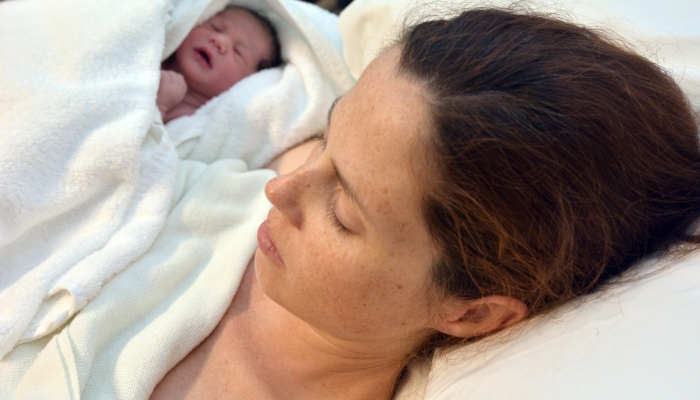
- A C-section is a major abdominal surgery, and you should treat your recovery like you would any other surgery.
- Finding a good sleeping position can be difficult after a C-section.
- Wearing comfortable and supportive sleepwear can help you avoid pain that wakes you up after your C-section.
- Using a body pillow for sleep can make sleeping after a C-section more comfortable.
- If you need to, you can talk to your doctor about pain medication or medication for sleep.
During the last few weeks of pregnancy, many women have a hard time finding a comfortable sleeping position. Pregnant mothers who normally sleep on their back or belly may long for the day they deliver just to get a few hours of blissful stomach sleeping. If you deliver via cesarean section, it may take a few extra weeks before you’ll be able to really get comfortable.
With a brand new baby to look after, getting good-quality sleep becomes more important than ever. Since a C-section is major abdominal surgery, you’ll need to do everything you can to rest and recover. Knowing how to sleep after a C-section is good for your mental, emotional, and physical health.
Why Good Sleep After a C-Section Is Important
Good sleep after a C-section is vital to the recovery process. During sleep, your muscles, skin, and nerves have time to repair themselves and grow back together. While you sleep, you also get more blood flow to an injured area. This means that more oxygen and nutrients are delivered to the area and you can recover faster.
Better sleep is also associated with better mental health and less frequent episodes of postpartum depression. Without good sleep, it will be harder to care for yourself and your new baby.
Getting good sleep can even help you fight infections and keep you from getting sick. If any kind of bacteria does get to your incision, you have a much better chance of fighting it off if you are sleeping well at night.
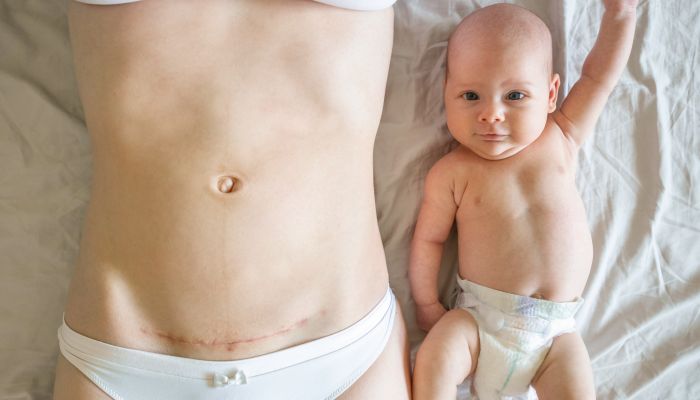
How to Sleep Comfortably After a C-Section
Many of the strategies used by pregnant mothers can be used post C-section to help you sleep comfortably. Just like during pregnancy, you’ll have to be careful not to put pressure on your abdomen or strain your abdominal muscles.
Body pillows
Body pillows are an excellent option for mothers recovering from a C-section delivery. Some mothers find it more comfortable to sleep at an incline for a few weeks after delivery. You can use large pillows folded or stacked to elevate your head and torso while you rest. This is also one of the best sleeping positions for obstructive sleep apnea.
For side sleepers, a pillow between the knees can help keep your hips aligned and avoid putting strain on your incision. A pillow between your knees keeps your entire upper body and spine in good alignment too.
Room temperature
Studies have shown that the ideal temperature for sleep is between 60-67 degrees. Being too hot disrupts your REM sleep. This can lead you to wake up feeling groggy, even after a long rest.
Being too hot while you sleep is not only uncomfortable, but if you wear a belly binder or supportive underwear after your C-section, you’ll be more prone to getting sweaty. Trapped sweat around your C-section incision puts you at higher risk of infection since bacteria love warm and moist environments.
Pain control
It is not uncommon to have pain at your C-section incision after delivery. Being in pain makes it difficult to fall asleep and stay asleep. Besides finding a comfortable position, you can use ice packs, heating pads, supportive underwear, and pain medication to help control your surgical incision pain.
Sleeping medications
If you have trouble falling asleep or staying asleep, sleep medication may be able to help. If you are breastfeeding, you’ll need to be more selective about the medications you choose. Ambien and Lunesta are generally considered safe for breastfeeding mothers.
Medications like Benadryl may dry up your supply, and melatonin has not been studied enough to know whether it is safe for breastfeeding mothers to take.
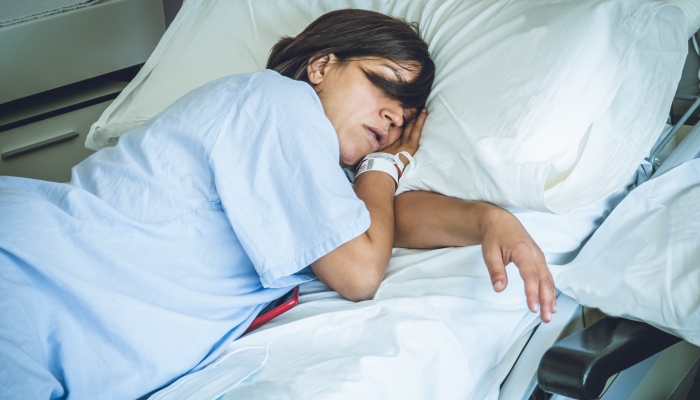
What Is the Best Sleeping Position Post C-Section?
The only sleeping position that you’ll have to avoid completely after a C-section is sleeping on your stomach. Stomach sleeping puts pressure on your incision and can irritate it. It may even lead to dehiscence, or your incision opening back up.
Sleeping on your back at a slight incline puts the least amount of pressure on your surgical incision. Sleeping on your side is also fine, but you may want to put a pillow between your knees to help with hip alignment .
How Much Sleep Do You Need for Optimal C-Section Recovery?
With a new baby at home, getting a full eight hours of sleep might feel impossible. Work schedules, breastfeeding and pumping, and other children in the home can all interrupt your sleep.
Any time you can, recruit neighbors, family, or friends to help you get some much-needed sleep after your C-section.
Hours of sleep after C-section
Ideally, you would get 7-9 hours of sleep per night after your C-section. The science is clear – you really do need to be getting at least 6 hours per night of sleep, even with a newborn at home.
Getting less than 6 hours of sleep each night puts you at risk of depression, getting sick, and poor cognitive function. People who are sleep-deprived, even after one night, have poorer memory and decision-making skills.
Naps after C-section
Do not worry if your baby is up all night and you aren’t able to sleep more than 6 consecutive hours through the night. Scientific evidence shows that you can benefit greatly from even a short 15-20 minute nap.
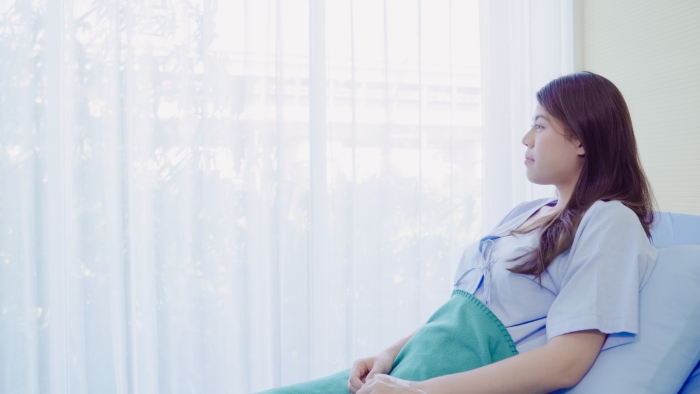
Additional Tips to Improve Your Sleep Quality
Good sleep hygiene is important for everyone, whether or not you have had a C-section.
Turn off your phone
After a long day of feeding your baby, changing diapers, and possibly caring for other family members, it is tempting to want to “wind down” with a few minutes of mindless scrolling on your phone. You might be missing work friends and wanting to catch up on the latest social media posts.
While there’s nothing wrong with a little phone time, using napping or sleeping time to scroll cuts into valuable sleep. The blue light from your cell phone also makes it harder to fall asleep once you stop scrolling. Avoid looking at your phone for at least 30 minutes before you try to sleep.
Avoid stimulants
A fresh cup of coffee is a fine way to get your morning started. If you are an all-day caffeine consumer, try to stop by 3 pm at the latest. The half-life of caffeine is several hours, and you don’t want that double espresso still circulating in your system when you lie down to go to sleep.
No screens in the bedroom
Phones are not the only screen keeping people up at night. Falling asleep with the television on is associated with worse sleep and more fatigue during the day. The same goes for computer and video game screens. To get the highest quality of sleep possible, remove all screens from your bedroom.
Ask for help
Lastly, and most importantly, don’t be afraid to ask for help. Many new moms feel pressured to “do it all” after having a new baby. Let someone else cook you dinner, leave the laundry for another day, and accept your mother-in-law’s offer to babysit if you can. Your sleep and recovery is especially important after a C-section.
For your own health and to be the best mother you can be for your new baby, prioritize sleep whenever possible.
FAQs
Can you sleep on your stomach after a C-section?
You will not be able to sleep on your stomach right after a C-section. After your surgery, you will need at least 6 weeks to fully recover. During that time, you will need to sleep either on your side or on your back.
Many women feel more comfortable sleeping at an incline with their head elevated, or on their side with a pillow between their knees. Do not resume sleeping on your stomach until your incision has been checked by your healthcare provider.
How should you get out of bed safely after a C-section?
Getting out of bed safely after a C-section means you’ll need to avoid the use of your abdominal muscles as much as you can. The best way to do this is to roll on your side and use your arms to lift yourself up to a sitting position at the edge of your bed. Give yourself at least 10-15 seconds of sitting at the edge of your bed before you stand. Delivery and surgery can make you feel dizzy or lightheaded, and giving yourself some time will help you avoid a dangerous fall.
Will it hurt to go to have a bowel movement after my C-section?
Having a bowel movement after you deliver your baby can be intimidating, to say the least. Your doctor should provide you with a prescription for stool softeners so that you do not have to strain during a bowel movement.
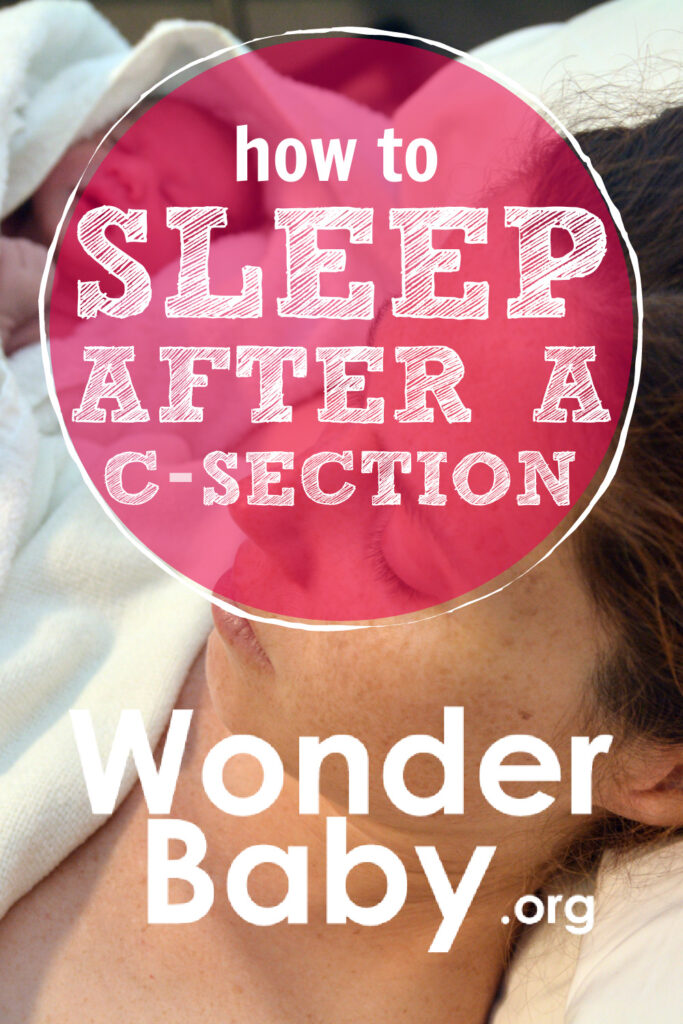
The information WonderBaby provides is not intended to be, and does not constitute, medical or other health advice or diagnosis and should not be used as such. Always consult with a qualified medical professional about your specific circumstances.
Related Posts
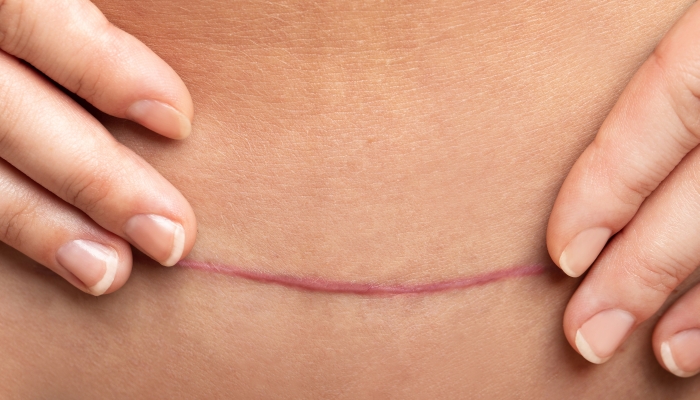
Pregnancy
How To Deal With an Ingrown Hair on a C-Section Scar
Ingrown hairs on a C-section scar can be treated using a warm compress or mild exfoliation. Infected ingrown hairs may require antibiotic treatment.
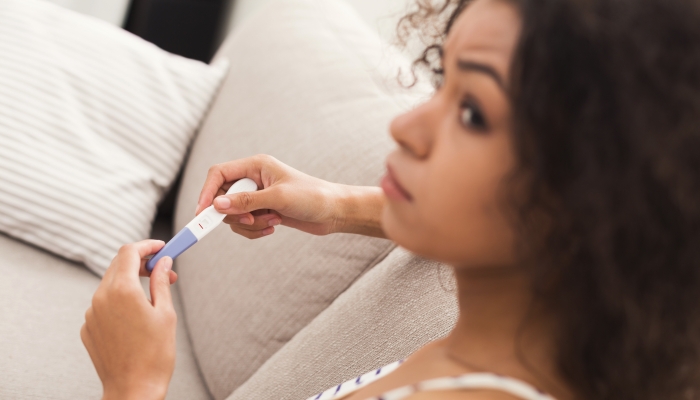
Pregnancy
What’s a Dye Stealer Pregnancy Test?
A dye stealer pregnancy test usually means that your hCG levels are very high, which is typically considered a good sign for pregnancy.
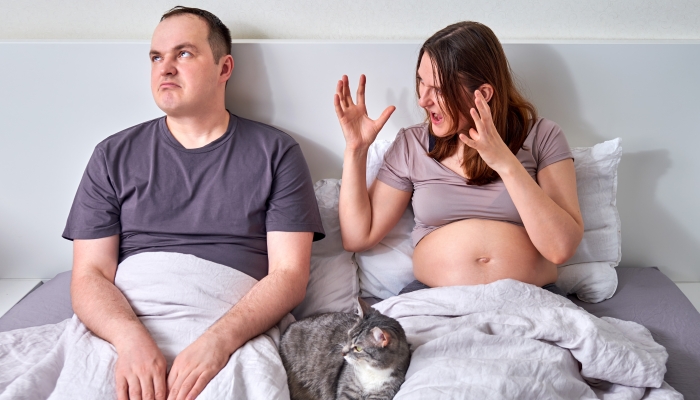
Pregnancy
Can Yelling Cause a Miscarriage?
Yelling alone can not cause a miscarriage. However, maternal stress can cause high blood pressure, preterm labor, and other health problems.